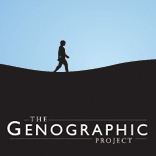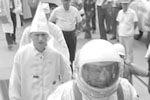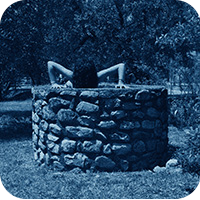The Genographic Project

OK, I’m pretty excited about this project. Today National Geographic and IBM announce a five-year partnership to map the patterns of dispersal and change of human DNA across the Earth. The goal is to develop an accurate picture of ancestral human migration patterns by analyzing genetic markers — mutations transmitted from generation to generation — in blood samples and cheek swabs from people all around the world. This is forensics on a global scale, macrogenealogy.
What makes this project unique, I think, is the opportunity for public participation. In addition to the indigenous populations that comprise a major part of the study, interested people anywhere can purchase a cheek swab kit and submit their cells for analysis. The process is completely anonymous. All your cells get is a barcode. The results can be interesting, sometimes dismantling preconceptions about one’s family lineage going way back. (One Italian-American IBM executive who participated in an early test was shocked to learn that his family line extended into the mountains of Iran. How his family got there from Africa is one question that this project hopes to answer.) Once you submit your cells and the DNA is analyzed you can log in to the site and see the migration patterns, such as they are known at that point, of which your family is a part.
This will be controversial, no doubt. Society itself (not to mention the racist mind) depends on a firm belief in where people come from, who they are, and who they are not — however dubiously tied to fact these beliefs may be. But better to know the real shape of the family tree than only to imagine it, no?
Info on the specifics of IBM’s involvement is available. Some coverage here and elsewhere.
A picture isn’t worth a thousand lines of code
I like to prattle on about poetry and code-writing. I’ve been known to do the same about images and poetry. But I’ve never invoked the transitive property to claim that painting and code-writing are kindred activities. Honestly, it never ocurred to me. Maciej Ceglowski ruminates on why this is such an awful analogy.
The Look-At-Me Cellphone Axiom
The amount that a person wants to look like he or she is using a cellphone in a public place — that is, how overt the person is about being on a call — is directly proportional to how advanced the receiver/speaker technology is. For example, people using cellphones in a normal fashion (handset-to-ear) are mostly unconcerned about letting people know that they are using a cellphone. (Though people using cellphones in this way can often be rude they are usually not deliberately so.) In contrast, people who use lavalier microphones are usually loud and demonstrative about the fact that there is no phone at their ear, waving the phone around like a prop to alert passersby to their hands-free-edness. And those with a Bluetooth headset? More theatrical still. Following the slope of wirelessness/overtness, it is fair to assume that when cellphone conversations can be beamed directly to the brain callers will be indistinghuisable from raving lunatics, gesticulating vigorously to let others know that, in fact, they have voices in their heads.
Humanities supercomputing
Some of the readership of this blog are people who work in the humanities — literature, criticism, art, museology — and some work in technology. Some work at the intersection of both, like me. So I figure this is a great place to pose a question that hit me like a hammer today.
Are there problems in the humanities that can only be solved by a supercomputer or some sort of distributed massive computing platform?
Anything that requires heavy doses of processor-crunching? Large corpus text analysis or image analysis? Help me here.
Protein folding, deep space radio astronomy, thermonuclear explosion modelling, meteorological forecasting and brute-force decryption cannot possibly be the only uses for supercomputing.
Do tell, do tell!
Google’s Ride Finder
My oh my how I am loving this arms race between Google, Yahoo, and Amazon. Google Labs is playing with an enhancement to Maps that plots the real-time position of a city’s cabs on the street grid. Here’s an example from around my building in Chicago. Plenty of other cities available too. Just more proof that flexible, open design almost always foments new innovation.
Now if you could only flag one of the cabs via the Maps interface it’d be perfect. Hear that, fleet operators?
[Via Gapers Block]
The pope thought my Italian sucked

I studied in Rome in 1993. My roommate was a seminarian who made it his job to get to know people at the Vatican. He ended up arranging a papal audience for us — nothing private, just part of the larger scheduled audiences — and he was able to situate himself (and me) right on the aisle down which the pope would stroll. Sure enough, il papa came right over to me and asked me where I was from. I responded in Italian (since he asked in Italian) that I was from Chicago. Smirking, he responded in English — presumably because my Italian was so atrocious — that he had visited Chicago many times. Then the stream of outstretched hands pulled him further along the aisle and my encounter with Pope John Paul II was over.
When I heard that the pope had died on Saturday I was preparing to attend the wedding of a friend. The radio broadcast I was listening to mentioned that a special service in Chicago would be held by Cardinal George at Holy Name Cathedral, the main Catholic church in the city, at 5:15pm. The wedding I was going to was scheduled for 4pm at that same church.
What a spectacle. Even as the wedding started a steady flow of mourners was filtering into the church, somewhat befuddled that a celebration was taking place therein. Once they figured out that the wedding would end soon enough they seemed not to notice it at all, filling in every open seat all the way to the front of the church. Meanwhile row after row of news cameras were sprouting up along the aisles. Seemingly entire orders of nuns marched solemnly in and took up seats very close to the bride’s and groom’s parents. A lone bridal party usher — normally a role whose most difficult task is figuring out which side of the church arriving guests should sit on — literally had to body-block churchgoers from entering the church down the center aisle. It was all somewhat surreal.
By the time the newlyweds turned around to face their family and friends, the vast cathedral was packed to overflow capacity — something I’d wager only the most regal weddings even come close to achieving in that space. The bride was completely dumbstruck at the sight. (And I bet the groom was thinking “I hope they don’t think they’re all coming to the reception.”) I have to admit that the bishop presiding over the wedding did a good job steering clear of what could have been a maudlin matrimonial ceremony, choosing rather to focus on the bride and groom almost exclusively. But the swell of silent, mourning Catholics into a space of such joy created one of the most unintentionally bizarre atmospheres I think I have ever witnessed. I’m having trouble dreaming up anything more ridiculous than the sight of weeping nuns pushed aside by a reporter from People Magazine (yes, People — huh?) trying to intercept the departing bride for an interview.
The Force is strong with this one
Hmmm, could be my son is watching too much Star Wars.
Today he was sternly reprimanded for smacking his little brother in the face while he demonstrated his light saber tactics.
Later, while crapping, he noted that his staccato farting sounded like laser blasts.
Then, he announced that he needed to go to Alabama because his imaginary friend’s sister Janey was being attacked by AT-AT Imperial Walkers there. (The fact that he knows Alabama being the most troubling part of that exchange.)
Back to Mary Poppins?
It was a different time back then, 1957 or ’58
This is one of the funniest things I have seen in ages. The Old Negro Space Program is a ten-minute documentary that’s one part Negro Baseball League, one part NASA, and all Spinal Tap. The parody of the professor and the crappy Photoshopping cracks me up. Keep your eye out for Peter ‘Stinky Pete’ Carver.
As a sidenote, NASA had a single African-American astronaut, Robert H. Lawrence Jr., during the race for the moon, but he died in an air crash in 1967.
[Via Coudal]
Recontextualizing the Collection
The paper I will be presenting at the Museums and the Web conference in Vancouver next month is now online. I know you can’t wait to get at it, so here’s an appetizer from a section called Tools of Representation.
All museums are places of technologically-enhanced representation. At its most fundamental level, a museum is a place for the re-presentation – the presenting again – of something created, used, or identified with someplace else. Many technologies or tools assist in this enterprise. Plate glass, cases, framing, interior architecture, lighting, climate-control, and signage combine to form a sometimes surprisingly high-tech, if mostly transparent, “machine” for the presentation of a cultural artifact, artwork, or other exhibit. Certainly more complex mechanisms exist. Interactive technologies both in physical space and on-line enable museums to act as platforms for the creation of an experience. In the manner that a theater stage is a kind of machine for the production of an experience or a run-time application is a virtual machine for enabling lines of code to be actualized, the museum today operates as an enabler of visitor experience. For many museums and cultural organizations, this experience is made possible by providing context. But it has not always been this way.
I know, I know, how dare I leave you with such a cliffhanger? The whole thing is located here.















